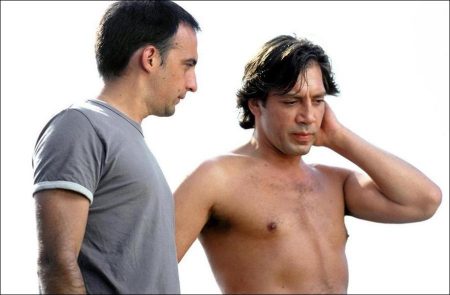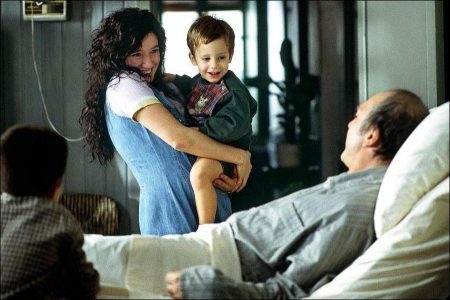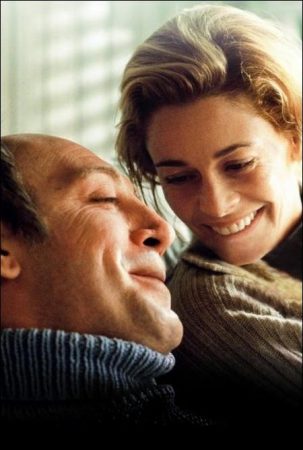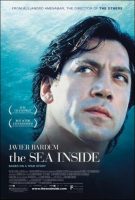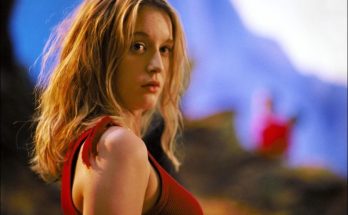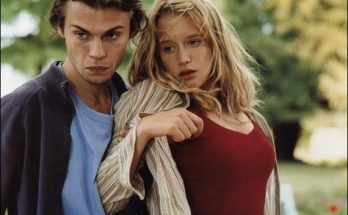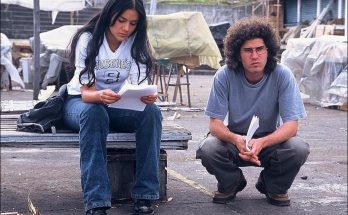The Sea Inside is the real-life story of Spaniard Ramon Sampedro, who fought a 30 year campaign in favor of euthanasia and his own right to die. Based on the profoundly moving true story that captured the world’s attention, The Sea Inside is about Spaniard Ramón Sampedro (played by Oscar nominee Javier Bardem), who fought a 30-year campaign to win the right to end his life with dignity. The Sea Inside is the story of Ramón’s relationships with two women: Julia (Belén Rueda) a lawyer who supports his cause, and Rosa (Lola Dueñas), a local woman who wants to convince him that life is worth living.
Through the gift of his love, these two women are inspired to accomplish things they never previously thought possible. Despite his wish to die, Ramón taught everyone he encountered the meaning, value and preciousness of life. Though he could not move himself, he had an uncanny ability to move others. A truly joyous experience, The Sea Inside celebrates the nature of freedom and love, and the mystery and beauty of life.
Former ship’s mechanic Ramón Sampedro has been paralyzed in bed for thirty years, tenderly cared for on a farm by four members of his family: his sister-in-law Manuela (Mabel Rivera), his older brother José (Celso Bugallo), his father, Joaquin (Joan Dalmau), and his teenage nephew Javi (Tamar Novas). Since his injury, Ramón has been known for his upbeat attitude and his warm smile; still, his sole wish has been to bring his life to a dignified end.
Former ship’s mechanic Ramón Sampedro has been paralyzed in bed for thirty years, tenderly cared for on a farm by four members of his family: his sister-in-law Manuela (Mabel Rivera), his older brother José (Celso Bugallo), his father, Joaquin (Joan Dalmau), and his teenage nephew Javi (Tamar Novas). Since his injury, Ramón has been known for his upbeat attitude and his warm smile; still, his sole wish has been to bring his life to a dignified end.
But the confines of Ramón’s world are opened up by the arrival of two women: Julia (Belén Rueda) a lawyer helping with his cause; and Rosa (Lola Dueñas), a local woman who wants to convince him to change his mind. The two women’s encounters with the charismatic Ramón will forever change both their lives and his. Like Ramón, Julia has lost mobility; she walks with a cane due to a degenerative disease. Living in his house, spending every day with Ramon to help his legal effort, Julia finds herself drawn to Ramón. Although Julia is married and Ramón is unable to leave his bed, an increasingly powerful connection develops between them. Ramón understands Julia more than any man she has ever known: he is the great love of her life, and she of his.
Rosa comes to Ramón a complete mess: a single mother with two children, she can’t hold a job and has a catastrophic history with men. She thinks that by helping Ramón, maybe she can help herself; Ramón quickly sees that Rosa is the one in desperate need of care. Over time, Ramón grows to enjoy her good-natured innocence, and freely bestows his wisdom and friendship. Rosa blossoms under Ramón’s attentions and his kindness literally saves her life.
About the Film
The Sea Inside began a few years ago when Alejandro Amenábar first read Ramón Sampedro’s book ‘Letters From Hell.’ “I was absolutely enthralled by the way he expressed himself,” says Amenábar. “And when I started interviewing the people who’d been close to him, I realized that this was a story definitely worth being told.”
Like all of Amenábar’s three previous films (The Other, Open Your Eyes, Thesis), The Sea Inside displays a fascination with the mysteries of life and death, topics that might seem unusual for a 32-year-old man. “I am interested in people,” he says, “and in what gives meaning to existence or strips it of meaning.”
To write the script, Amenábar turned to his friend and fellow director Mateo Gil, with whom he had previously collaborated with on the outline for Thesis and the screenplay for Open Your Eyes. “He seemed the ideal person to work the dreamlike realm into the story,” says Amenábar.
In order to tell Ramón Sampedro’s story in two hours, some of the real people in his life had to be eliminated and others had to be incorporated. For example, the character of Julia represents a group of women that loved Ramón after he was incapacitated. And while the nephew Javi in the film has some connections with the real person, many elements of Ramón’s nieces were blended into the character.
“When there are real people behind the characters, you need their authorization,” says The Sea Inside producer Fernando Bovaira (The Other, Open Your Eyes). “But I think we were delicate enough to make sure that no one felt uncomfortable. We showed them an almost finished screenplay and they gave their authorization for Alejandro to work freely.
The scriptwriters decided not to chronologically detail the ups-and-downs of Sampedro’s legal battles. “It’s the sort of thing you’re either interested in or not, says co-screenwriter Gil. “And if you’re not, it can become rather tedious.” Also, Amenábar felt that the legal issues would eventually be resolved and if the film focused there it would eventually become dated. “It seemed more important to me,” says Amenábar, “that someone seeing it in a few years should continue to give thought to the whole issue of what is life and what is death.”
The success of the film hinged on finding a brilliant actor to portray Sampedro, who was 55 at the time the story is set. After first looking in the theatre for actors of the appropriate age, Amenábar chose 35-year-old Javier Bardem, Academy Award nominee for Julian Schnabel’s Before Night Falls. While Bardem had played a man in his forties in the award-winning Mondays in the Sun, he had never portrayed a character this old, and didn’t speak Sampedro’s Galician language. “I think that Javier is the best actor Spain has ever produced,” says Amenábar. “”I offered him the part and told him he could back out whenever he wished.” But Bardem was enthusiastic about the challenges posed by the part. “A role like this is very rare,” he says. “Every actor in the world would pay to play it.”
Once he was cast, Bardem immersed himself in the world of Ramón Sampedro. “I spoke to family members and people that were close to him,” says Bardem. “And they all said the same thing—he was a very happy person. He was actually the kind of person that you would pay a visit to in order to cheer yourself up. As an actor, I thought it was a risky thing to work with: a man who wants to die but at the same time is always smiling.”
Bardem read Sampedro’s two books, ‘Letters From Hell’ (collected writings) and ‘Cando eu Caia’ (poetry), watched documentary footage and studied the Galician language. He also went to a hospital where they were treating people with similar disabilities. “I spent time with them trying to figure out how not to move,” says Bardem. “Which is very hard to do; it’s easier to move. But it was something I really wanted to work with, because I consider myself a very physical actor; I always put body language into my characters because I think it’s very important the way we reveal ourselves through our unconscious movements. My big goal was to relax, and to try to express the motions with the voice and the eyes.”
At the hospital, Bardem also learned that Sampedro had difficulty breathing, as he wasn’t able to move his diaphragm. “That gave me a perspective on how to play him,” says Bardem, “because a man who can’t breath well is a man who has to talk very fast and be very precise in what he says—he doesn’t have time to waste.
Also, since I’m quite big and bulky, we had to find the right position to hide my shoulders by keeping my back in a bent posture.” A physiotherapist was hired to prepare a special pillow for the actor, which allowed him to keep his back in the correct position.
To transform Bardem into a convincing man in his mid-fifties, Bardem had his head shaved and went through a grueling five-hour session every day with celebrated English makeup artist Jo Allen (The Hours, Gladiator). “I was looking for something very realistic,” says Amenábar, “something that would make people forget that the actor who was playing this guy was Javier Bardem.”
“I spent three months in bed,” says Bardem. “I woke up at five am every morning and went to a bed for five hours; immediately afterwards I went to another bed to shoot the film for eight to eleven hours. After that, I went to sleep in my own bed. I wanted to learn to sleep upside down like a bat—I was tired of being in bed the whole day!”
“The makeup really helped me with my work,” says Bardem. “When I saw myself in the mirror, made up like that, I relaxed, because it always brought an important sense of reality to things. All I had to do was match the character to the makeup.”
If playing a bedridden man in his fifties speaking in a language vastly different from his own wasn’t enough, Bardem also had to learn to write using a stick in his mouth. “I can’t tell you how difficult it is,” he says. “You spend more than fifteen minutes trying to put your name on a piece of paper. It’s really painful. In the end I was only able to write a few things, but not even a whole line.”
“Despite all the constraints, Javier never complained,” says Amenábar. “He was always dishing out generous doses of good humor. I wanted all the actors to have a good time on the shoot, and Javier was fundamental to creating that atmosphere.”
“All those technicalities helped me not to lose my concentration,” says Bardem. “And they made me understand that Ramón, from his situation of physical immobility, was extremely alert to all the very little things that went on around him. He was by no means someone who had given in to his lot.”
“Javier was the soul of the film,” says Amenábar. “We could feel Ramón there on the shoot. While Ramón was capable of laughing at his situation, we didn’t want to turn him into the clichéd funny guy with a joke for every situation. Javier helped give him the right tone, because he also has a great sense of humor, and he understood the man and the character perfectly.”
Belén Rueda, a famous TV personality, comedienne, and actress in Spain, makes her film debut as Julia. “I knew she had the emotional complexity as well as the capacity for imagination and improvisation necessary to play opposite Bardem,” says Amenábar. “Her character isn’t there to provide comic relief; she is a dramatic character. But the presence of Belén brought light to the story. When you see her in any scene, you’re seeing someone who’s very full of life.”
“When I read the script, I didn’t think twice about the character,” says Belén. “I understood Julia from the very first moment—the tears that came to my eyes were real. While going from television to film was very hard, Javier Bardem is a very generous professional and he helped me a great deal. And Alejandro knows how to create an atmosphere of great enthusiasm, and a very relaxed atmosphere as well; no matter how many hours you spent there, you never felt exhausted.”
To play Rosa, the other woman in Ramón’s life, Amenábar chose one of Spain’s most accomplished actresses, Lola Dueñas (the nurse in Almodóvar’s TALK TO HER). “Lola has all the brazen qualities of the character she plays, that touch of madness, as well as the intensity and humor,” says Amenábar.”
“Ramón used to say about Ramona Maneiro, the person on whom my character is based, that she was ‘a universe in search of meaning,’” says Dueñas. “I thought it was a perfect definition of her. She’s a woman with a very big heart, but is a complete emotional mess. She’s got lots of love to give, lots of time to give it, but is completely lost because she has nowhere to send it. What she is looking for in Ramón is really a way to feel useful to someone, to feel loved. And Rosa discovered love at Ramón’s side—that’s why I admire her so. There aren’t many people who know how to love.”
For much of the supporting cast, Amenábar chose actors who had little or no film experience. “You’ve got to give opportunities to new people,” says Amenábar. “Most of them are unknown,” says Bardem, “but you can tell they are amazing actors when they show up for the reading. And it is a tribute to Alejandro, who could have any actor in the world, that these actors are inspired do the kind of work that they do in this film.”
Clara Segura plays Gené, the vibrant representative of DMD – Derecho a Morir Dignamente (which translates as Right to Die with Dignity). “Gené is all for life, though she does defend the right to die,” says Segura. “She is very fun-loving but also someone who has firm convictions. The relationship between Ramón and Gené is based on an implicit understanding that has arisen after many intense conversations; it is a healthy friendship, one of mutual admiration.”
Mabel Rivera plays Manuela, Ramón’s sister-in-law, the quiet presence who attends to his needs. “Manuela is the wife-mother who is taking care of him all the time in a special way,” says Rivera. “She might be negligent in her care of certain members of her family, of her children even, but never of Ramón.”
Ramón has a paternal relationship with his nephew Javi (Tamar Novas) and a more complicated relationship with his big brother José (Celso Bugallo). “José considers himself the head of the family and, as such, thinks he has a right to decide whether his brother should be allowed to entertain the option of euthanasia or not,” says Bugallo. “That’s how he understands his love for his brother, and it’s an attitude which leads him, at times, to be a touch aggressive.” Finally, there is Ramón’s father, Joaquin, played by Joan Dalmau.
“My character is a man who doesn’t eloquently externalize his pain, which has been brought on by his son’s tragedy. That’s very normal in the Galician man; he feels a lot, very deeply, but keeps it all to himself.”
The original plan for the production was to build the house in Galicia in the best landscape available, but the filmmakers discovered that the climate was too unpredictable. The decision was made to return to the same studio where Amenábar shot The Others, in a smaller set, with blue screens for the windows.
“I’ve always been one for those little artifices,” says the director. The exterior locations were found in the area of Xuño in Galicia, always within a radius very close to where Ramón lived. In order to give variety to the visual style of the film, Amenábar chose locations in Barcelona to serve as a counter to Galicia, giving a visual interplay between urban and rural Spain.
With The Sea Inside, Amenábar turned to many familiar colleagues from his previous films. In addition to co-screenwriter Mateo Gil and producer Fernando Bovaira, the film’s credits include line producer Emiliano Otegui (all of Amenábar’s features); as well as director of photography Javier Aguirresarobe, art director Benjamín Fernández, and costume designer Sonia Grande—all of whom worked on The Others.
Shooting began in Galicia in July of 2003 and continued for three months. At their arrival, some of the actors had the chance to meet the real people they were going to play. “I think I really milked Ramona Maneiro for all she was worth,” says Lola Dueñas, “because I took along a camera and recorded her. It must have been hard for her to talk with someone who was recording her and looking at her, because it wasn’t exactly a normal conversation. She was very generous.”
The actors were also deeply affected by being in the beautiful and authentic Galician locations. Ramón’s accident was filmed at Furnas beach, the place it really happened. To help the actors through the emotional journey of the story, Amenábar shot the film in chronological order.
Also, for the first time in his career, Amenábar employed a new technique in his direction of actors: improvisation. “In order to find the real truth of the characters, I tried as much as possible to avoid rehearsal or to have them learn their lines too well in advance,” says Amenábar. “We improvised constantly. And if we ever thought that something sounded stilted or unnatural, I was open to having it changed. Because, at the end of the day, I wanted to be open to the possibility of them not interpreting the characters as I had conceived them in my head, to see what they might have to offer. What is seen in the final edited version of the film is really improvised by them, especially by Belén in the most dramatically charged moments.”
“Alejandro knew how to make us believe we were changing something by making us voice how we felt things, says Belén. “Afterwards we’d realize that we hadn’t really departed from what was originally written. What was in the script was there for a purpose.”
“As a director, Alejandro is a very quiet, sensitive and smart person,” says Bardem. “He always approaches you in a very kind way and lets you know that he supports you; but at the same time you are free to really improve or go wherever you feel you want to go.”
As with all his previous films, Amenábar composed the musical score. “I tried to be more methodical than ever, starting from three major themes—representing Ramón, Julia and Rosa. Rosa is the more Celtic bit; Julia the symphonic; and Ramón a mixture of both, with a strong epic content. Later on, my collaborator Carlos Nuñez came in, and we went to Galicia and turned the final piece into a real celebration of life. Sampedro’s love for classical music, specifically for opera, was also important and this is also reflected in the film.”
The title of the film comes from one of Sampedro’s poems, and certainly the idea of the sea was never far away from his thoughts. “As he says in the movie, the sea gave him a life when he was a sailor and it also put him in that situation,” says Bardem. “But I would also say that the sea means to him what it means to all of us: freedom, and a mysterious place that no one really understands. It’s like death. We all talk about it, but we don’t know what’s after it; and we don’t know what’s under the sea.”
The Sea Inside can also be seen as a love story, or even as a series of love stories. “It shows the different ways in which love can be conceived,” says Amenábar.
“First there is the protective kind of love that’s established with Rosa, because she would go to him with her problems. Then there’s Julia, the intellectual connection—they share similar concerns but have totally different visions of life and death. Then there is the father/son relationship with his nephew. The relationship of love and fraternal miscommunication with his brother José is also very important. Finally, there is the relationship with his sister-in-law, one of implicit understanding, deeply maternal, where words are not necessary because a simple look says it all.” “In The Sea Inside,” says Dueñas, “love is the driving force behind everything.”
“I would say this movie talks about love with possession and love without possession,” says Bardem. “And the question would be: are you able to love somebody without possessing them? And there are two women in the movie who will give him two different answers.”
The Sea Inside is likely to open a debate on many of the issues raised by Ramón Sampedro’s life. “I did a movie with Almodóvar called Live Flesh where I played a man in a wheelchair who became a huge international basketball player,” says Bardem. And I admire, support and really envy the guys that I worked with in that movie: people who are in those circumstances and are willing to go ahead and have a life. But that doesn’t mean that I don’t also support somebody who says, ‘Excuse me, I have an opinion—I want to stop.’ Ultimately, it’s the only belonging that we have: our own life. And we have the right to do with it whatever we want to do with it as long as we don’t hurt anyone.”
Despite what might be seen as a downbeat subject, the film is a strikingly uplifting and luminous experience. “The Sea Inside is a celebration of freedom, and a guide to looking at life from another perspective,” says Clara Segura. “It is magical,” says Mabel Rivera, “it explores the landscapes of an inner journey.”
“The Sea Inside makes you think about things that are part of life,” says Belén. “You come out of it thinking how beautiful it is to live.”
The Sea Inside (2004)
Directed by: Alejandro Amenábar
Starring: Javier Bardem, Belén Rueda, Lola Dueñas, Mabel Rivera, Celso Bugallo, Clara Segura, Joan Dalmau, Alberto Jiménez, Tamar Novas, Francesc Garrido, Josep Maria Pou
Screenplay: Alejandro Amenábar
Production Design by: Benjamín Fernández
Cinematography by: Javier Aguirresarobe
Film Editing by: Alejandro Amenábar
Costume Design by: Sonia Grande
Set Decoration by: Emilio Ardura
Art Direction by: Benjamín Fernández
Music by: Alejandro Amenábar
MPAA Rating: PG-13 for intense depiction of mature thematic material.
Distributed by: Fine Line Features
Release Date: December 17, 2004
Views: 89
